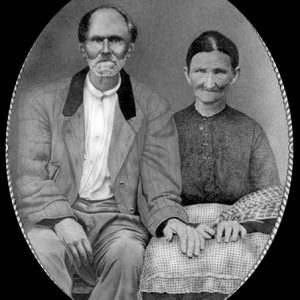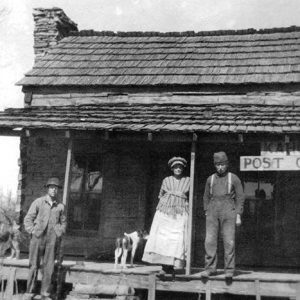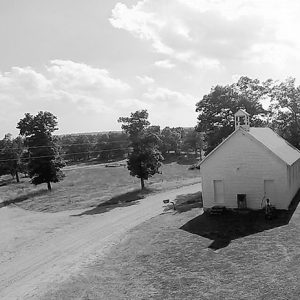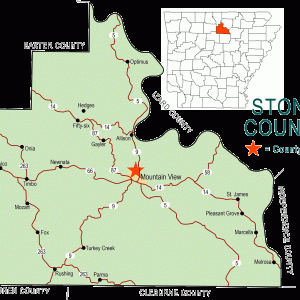calsfoundation@cals.org
Kahoka (Stone County)
Kahoka is in Arbana Township located southwest of Highway 5 (Mountain View Road) on Misenheimer Road (Highway 28) just before its intersection with Berry Lane. Mountain View (Stone County), the county seat, is approximately nine miles northwest of Kahoka, and Pleasant Grove (Stone County) is four miles to the east.
The Osage were in the hills when French and Spanish explorers first entered the wilderness. The Cherokee began arriving in the Ozark Mountains around 1817. At the invitation of the Cherokee, Shawnee from the Ohio River Valley entered the Ozarks and settled west of the White River on Crooked Creek, with their main settlement at Shawneetown, which later became Yellville (Marion County). The Cherokee may have expected the Shawnee to aid them against the Osage. Shawnee villages could also be found in the Livingston and Sylamore Creek valleys along the White River and along Bear Creek in Searcy County. Chalybeate Spring may have been utilized by the Osage and, later, the Cherokee and Shawnee.
Because of the difficulty in making a living from farming there, and because of its isolation, Kahoka did not attract settlers until after the Civil War. Only a few hunters and trappers ventured through the rugged wooded mountains, which were full of small game such as squirrels and rabbits, as well as deer and bears and plentiful fish and beavers along the streams of Chalybeate Spring Creek and Little Raccoon Creek.
Chalybeate water from the Bon Air Spring, one of three springs located close together about two miles south of Kahoka, was believed by some to have healing powers. It is the only one of the three springs used for its medicinal properties. The water from the spring was first collected by T. C. Hopkins on December 18, 1891, and analyzed by A. E. Menke. It forms the waters of one of the small tributaries of Coon Creek, which flows into the Devil’s Fork of the Little Red River.
The nearby Stone County settlements of Hess Town (Wallace Creek, Marcella), Red Stripe (Pleasant Grove), and Buck Horn (St. James) took root before the Civil War, as pioneer farmers were attracted to the alluvial White River bottom land. Bon Air Spring was part of the hinterland wilderness. Corn was a main crop in the surrounding hills, and the moonshine from the Hess distillery at Wallace Creek was considered the best in that part of the state. Also, the thickly wooded region was a lure for early settlers who worked in the timber.
The Kahoka Post Office opened in 1898 with John Fell Sansom appointed postmaster. By this date, the township of Chalybeate Springs had been created, and the term Bon Air for the major spring and the region was falling into disuse. John and his wife, Christina Mittie Bechtol Sansom, who helped her husband with the post office, were from Kahoka in Clark County, Missouri, and that is likely how the community got its name. The local pronunciation of Kahoka (or sometimes Kahokia) is Ka-hó-key. The name Kahoka is derived from the Cahokia tribe of the Illiniwek or Illinois Confederacy. The Kahoka post office closed in 1955.
There is another name-origin story, this one based on the Hester family Bible. William Abraham Hester from South Carolina and his Cherokee wife, Nancy Ann Ward Hester, of the Cherokee Nation in Georgia, were among the first to settle the Bon Air backwoods west of White River. William had filed a land grand before the Civil War for the land but did not move to the community until after the war, living first in Buck Horn (St. James). Nancy Hester is said to have been responsible for naming the community Kahoka after the Cahokia tribe.
The mountainous backwoods gained a reputation for lawlessness. In one instance, William H. Sanders was killed in a shootout in Kahoka at the Hub Mill in 1919.
A noted citizen of the area was Harold Morrow Sherman from Michigan, a popular author and lecturer in the fields of self-help and extrasensory perception (ESP), who in 1947 settled with his wife in an old house at Kahoka near Chalybeate Spring. The house was located in the woods on 140 acres. He wrote about his love for Stone County and believed the isolation and seclusion would promote his writing and psychic powers. Sherman teamed with Timbo (Stone County) folk artist Jimmy Driftwood in the 1950s and 1960s to write a never-produced musical and a TV pilot shot in the Mountain View area called “The Amazing Adventures of My Dog Sheppy.” He helped bring paved roads and electricity to Stone County, as well as helping Driftwood receive federal funding for the Ozark Folk Center in Mountain View and the nearby Blanchard Springs Cavern.
Kahoka in the twenty-first century is virtually a forgotten community, even in Stone County. The only business is the Hummingbird Ridge RV Repair on Highway 5. The community’s main attraction is Camp Kahoka, a popular summer church camp that also hosts retreats and religious back-to-nature workshops. Most of those who live in the area work and shop in nearby Mountain View.
For additional information:
“Chalybeate Springs Township, 1910 Census.” Heritage of Stone 8, no. 2 (1981).
George C. Branner, State Geologist, State of Arkansas, Arkansas Geological Survey. “Data on Springs in Arkansas,” Compiled Under the Direction of George C. Branner, Little Rock, 1937. https://www.geology.arkansas.gov/docs/pdf/water/springs-in-arkansas.pdf (accessed September 8, 2020).
Harold Morrow Sherman Collection. University of Central Arkansas Archives and Special Collections, Conway, Arkansas.
Kenneth Rorie
Van Buren, Arkansas
 William and Nancy Hester
William and Nancy Hester  Kahoka Post Office
Kahoka Post Office  Norick's Chapel
Norick's Chapel  Stone County Map
Stone County Map 



Comments
No comments on this entry yet.